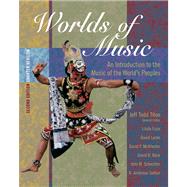
| Music Culture as a World of Music | |
| The Soundscape | |
| The Music-Culture | |
| Music or Nonmusic? | |
| Patterns in Music | |
| A Music-Culture Performance Model | |
| The Four Components of a Music-Culture | |
| Ecological Worlds of Music | |
| Study Questions | |
| Glossary Resources | |
| North America/Native America | |
| The Sioux Musical Style (Close Listening: Grass Dance, Traditional Sioux War Dance The Zuni Musical Style; Close Listening: Zuni Lullaby) | |
| The Iroquois Musical Style (Close Listening: "Gadasjot," Quiver Dance or Warrior's Stomp Dance Song) | |
| Musical Life of the Navajos (Close Listening: Yebichai, Navajo Dance Song; Close Listening: "Folsom Prison Blues"; Close Listening: "Shizhan?'?," Navajo Circle Dance Song; Close Listening: Hymn of the Native American Church; Close Listening: "Clinging to a Saving Hand," Traditional Christian Hymn) | |
| The Native American Flute Revival | |
| Study Questions.Glossary | |
| Resources | |
| Africa: Ewe, Mande, Dagbamba, Shona, BaAka | |
| Postal Workers Canceling Stamps (Close Listening: Postal Workers Canceling Stamps at the University of Ghana Post Office) | |
| Agbekor: Music and Dance of the Ewe People (Close Listening: Agbekor Vulolo; Close Listening: Agbekor Adzo; Close Listening: Agbekor Vutsotsoe; Close Listening: Performance Demonstration of an Agbekor Percussion Ensemble) | |
| The Jaliya of the Mande (Close Listening: "Lambango," a Mande Song) | |
| Drummers of the Dagbamba (Close Listening: "Nag Biegu," Traditional Praise Name Dance Song) | |
| Shona Mbira Music (Close Listening: "Nhemamusasa," Traditional Shona) | |
| The BaAka, Forest People (Close Listening: "Makala," a Mabo Performance Event) | |
| Conclusion as Discussion | |
| Study Questions | |
| Glossary Resources | |
| North America/Black America | |
| Music of Worship (Close Listening: "Amazing Grace") | |
| Music of Work (Close Listening: Field holler; Close Listening: "Rosie" (call and response excerpt); Close Listening: "Rosie") | |
| Music of Play | |
| Blues (Close Listening: "Poor Boy Blues"; Close Listening: "She Got Me Walkin'"; Close Listening: "Ain't Enough Comin' In") | |
| A Few Final Words | |
| Study Questions | |
| Glossary Resources | |
| East Asia/Japan (by Linda Fujie) | |
| General Characteristics of Japanese Traditional Music | |
| The Shakuhachi (Bamboo Flute) (Close Listening: "Tsuru no sugomori" ("Nesting Cranes")) | |
| The Kouta (Short Song) and Shamisen (Lute) (Close Listening: "Hakusen no" ("A White Fan")) | |
| Folk Song (Close Listening: "Nikata-bushi" ("The Song of the Nikata")) | |
| Popular Music (Close Listening: Taiko (Drumming); Close Listening: "Naite Nagasaki" ("Crying Nagasaki")) | |
| Final Words | |
| Study Questions | |
| Glossary Resources | |
| India/South India | |
| Culture, History, Politics | |
| The Classical Music of South India | |
| A Carnatic Music Performance (Close Listening: "Sarasiruha," Kriti in Natai raga, Adi tala) | |
| Indian Music and the West | |
| Study Questions | |
| Glossary Resources | |
| Asia/Indonesia | |
| Central Java | |
| Gamelan (Close Listening: Performance Demonstration of a Javanese Gendhing, "Bubaran Kembang Pacar"; Close Listening: Playon "Lasem" sl?ndro pathet nem, Central Javanese Gamelan Music for Shadow Puppetry) | |
| Bali (Close Listening: "Kosalia Arinim," Gamelan Gong Kebyar) | |
| Popular Music (Close Listening: "Shufflendang-Shufflending," Ethno-Jazz Fusion of West Java) | |
| Conclusion | |
| Study Questions | |
| Glossary Resources | |
| Latin America: Chile/Bolivia/Ecuador/Peru | |
| Chilean Nueva Canci?n (Close Listening: "El aparecido" ("The Apparition")) | |
| Bolivian K'antu (Close Listening: "Kuitimunapaq" ("So that we can return")) | |
| The Quichua of the Northern Andes of Ecuador (Close Listening: "Muyu muyari warmigu" ("Please return, dear woman"), a Quichua Sanju?n; Close Listening: "Iluman tiyu" ("Man from Iluman"), a Classic Sanju?n of the Imbabura Quichua) | |
| African-Ecuadorian Music of the Chota River Valley (Close Listening: "Me gusta la leche" ("I like milk"), an African-Ecuadorian Sanju?n) | |
| The Andean Ensemble Phenomenon: Going Abroad (Close Listening: "Amor imposible" ("Impossible Love"), Traditional Peruvian wayno) | |
| Afro-Peruvian Music (Close Listening: "Azucar de bana" ("Sugar Cane"), an Afro-Peruvian Land? Despedida, or Farewell) | |
| Study Questions | |
| Glossary Resources | |
| Discovering and Documenting a World of Music | |
| Music in Our Own Backyards | |
| Doing Musical Ethnography | |
| References | |
| Index | |
| Table of Contents provided by Publisher. All Rights Reserved. |
The New copy of this book will include any supplemental materials advertised. Please check the title of the book to determine if it should include any access cards, study guides, lab manuals, CDs, etc.
The Used, Rental and eBook copies of this book are not guaranteed to include any supplemental materials. Typically, only the book itself is included. This is true even if the title states it includes any access cards, study guides, lab manuals, CDs, etc.